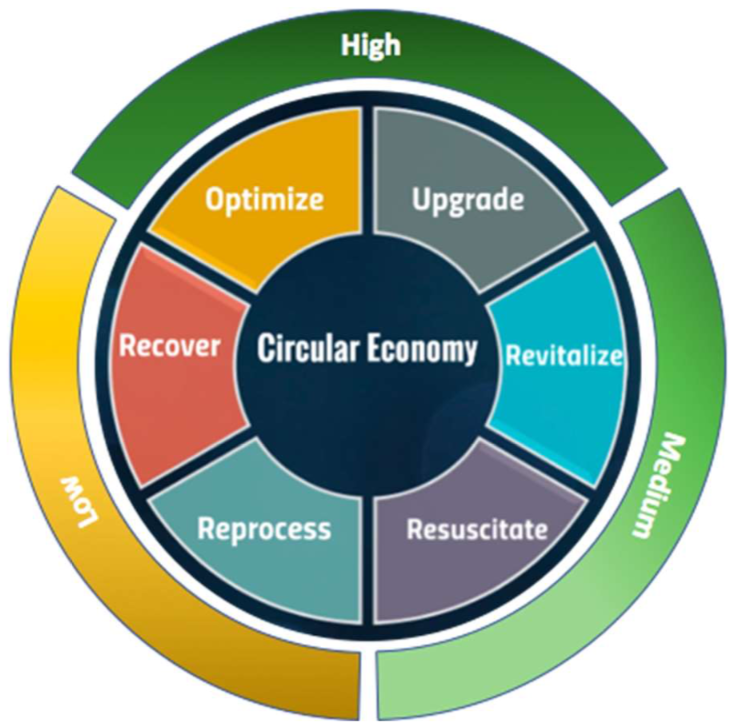This article is an executive summary of the Charting a Course for a Canadian Transition to a Circular Economy report. You can access the full Pollicy Lab report here.
There is growing global interest in the circular economy, but these discussions tend to focus on the relationships between manufacturers and consumers, neglecting the need for primary resources. World demand for goods and services is increasing. Since we cannot reuse materials forever, we need to inject new materials into the production cycle. Canada plays an essential role in the global economy as a supplier of energy and materials. Natural resource extraction and development are integral to its economy. Canada needs its own approach to the circular economy that recognizes the economic importance of natural resources, and that addresses the environmental impacts of these activities.
This paper explores obstacles and opportunities for Canada’s natural resource sectors’ transition to a circular economy. It looks at the three sectors of mining, energy, and forestry, and focuses on optimizing circularity at the extraction and processing stages. It also looks at environmental impacts such as pollution, including greenhouse gas emissions, and biodiversity loss. However, it does not directly address the manufacturing or consumer stages, nor does it propose implementation strategies. These elements exceed the scope of this project.
 What does it mean for a resource-based economy to be “circular”?
What does it mean for a resource-based economy to be “circular”?
A resource-based circular economy is resource-and energy-efficient. It uses the smallest necessary quantity of inputs in order to extract and process natural resources. It also maximizes value while minimizing waste. It seeks opportunities to create value within the economy from its residual materials and energy.
In a Canadian context, an effective circular economy also requires strong partnerships with Indigenous peoples, equity among other groups, better coordination across jurisdictions, and clear policy signals.
Why are market forces not enough to move Canada to a circular model?
Several obstacles stand in the way. A lack of information or knowledge can make it difficult for extraction and processing firms to make and sell new products or find new uses for residuals; information gaps also make it difficult for policymakers to target circularity precisely. Technological obstacles, like the inability to efficiently extract some minerals at low concentrations, or the ability to efficiently store solar energy long-term, also pose challenges. Liability and Regulatory barriers like multiple layers of jurisdiction, and complex or expensive regulatory burdens all make it more complex for firms to change processes and try new things.
In addition, many of the changes needed to improve circularity can increase short-term costs and affect competitiveness for natural resource firms. Without clear policy or demand signals, the long-term payoffs of making these changes are uncertain.
So why transition to a circular economy?
Many international markets have already begun shifting towards greater circularity. To remain competitive in the long term, Canada needs to keep up. However, it is not just the threat of being left behind, but also the opportunities to move to the front of the pack, that should motivate Canadian governments and industry.
Canadian firms can gain a long-term competitive advantage through circularity. It will require time and effort to adjust, but it can lead to long-term boosts in economic growth. Circularity creates opportunities to promote new investment in research and infrastructure, and to develop new market opportunities. Finally, based on experiences in other countries, experts anticipate that circular economic approaches will create jobs. By reducing waste, circularity provides opportunities for resource-sector activities to reduce social and environmental impacts like pollution from greenhouse gas emissions.
What can Canada do to support a transition to circularity in the natural resources sector?
Many policy options could help drive Canada’s economy towards circularity. Our recommendations would have long-lasting effects and will remain relevant in a variety of economic contexts. Natural Resources Canada can play a key role (directly or indirectly) in each of these five recommendations:
- Support decontamination and re-mining: Re-mining and decontamination contribute to circularity by retaining value and by restoring the health of ecosystems. The federal government can create a five- to ten-year pilot project to provide financial support for decontamination and re-mining of residual materials from orphaned and abandoned mines. Natural Resources Canada can also support research and development. This recommendation addresses the need for action on abandoned mines across Canada. It also fills a gap in the development of techniques to extract value from residual mining materials by scaling up and commercializing new technologies.
- Support renewable-energy district heating systems: Renewable-based district heating contributes to circularity by increasing overall energy efficiency and by replacing fossil fuels. Natural Resources Canada can extend its support over the next ten years for renewable-energy-based district heating systems by funding upgrades and new test systems, by providing technical support, and by facilitating knowledge- sharing. By helping communities overcome high upfront costs to demonstrate this technology, Natural Resources Canada can support renewable energy and promote efficient heating solutions, especially in remote and rural communities.
- Continue to support new technology development and adoption in Canada: By supporting new clean energy projects to reach commercialization, this recommendation promotes a future shift to renewable energy and materials. Natural Resources Canada should support the continued funding of the Sustainable Development Technology Fund but work to adjust the environmental performance criteria for eligibility to reflect circular economy principles. This policy also supports Canadian competitiveness in global export markets and sends clear signals to industry about Canada’s commitment to circularity.
- Work to reduce harvesting of old-growth forests: Encouraging firms to adopt sustainable practices and maximize the value from harvested goods will support a more renewable approach to forestry and will help retain ecosystem health in some of Canada’s oldest and most biodiverse regions. It will also protect the large carbon sinks that exist within these forests. Natural Resources Canada should facilitate discussion among Indigenous communities, provinces, and industries to reduce harvesting of old-growth forests, focusing on maximizing value from harvested goods.
- Support industry by filling in network and knowledge gaps: Better networks and data could improve circularity of all types. Circularity requires new collaborations between stakeholders. A proactive network or concierge-type service would help link circular economy stakeholders together until such networks develop within the market. Better data would complement this effort by helping develop future policies that would improve circularity.
Putting these and other measures in place and sending clear messages to stakeholders about Canada’s commitment to a circular economy, will help Canada make a transition to circularity. However, this report is the beginning of the journey. Much more work will be needed to support and incentivize all sectors of the Canadian economy into a circular model.
This Policy Lab was presented by our MPPs on July 10, 2020. Watch the video below:
About the Authors
 Sumaiya Kabir Talukder
Sumaiya Kabir Talukder
MPP Class of 2020
 Matthew Zammit-Maempel
Matthew Zammit-Maempel
MPP Class of 2020
 Shirley Zhang
Shirley Zhang
MPP Class of 2020




